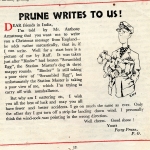 ‘This bloody station’s a right bloody cuss, no bloody pubs and no bloody bus;
‘This bloody station’s a right bloody cuss, no bloody pubs and no bloody bus;
Nobody cares for poor old bloody us. Oh, bloody bloody bloody bloody bloody!
For a MidCentury boy like me, brought up on a steady diet of 1950s war movies, Airfix kits, Action Man and War Picture Library comics – all of which either have or will feature in this blog – it came as a bit of a surprise to discover that the wartime generation enjoyed their own comic heroes. Why it was a surprise, I can put down only to my own naivety and a youthful assumption that everyone would have taken the war with unrelenting seriousness. But why should the 20-somethings of the 1940s have been any different from their predecessors who lapped up ‘Ole Bill cartoons in the First World War, any more than from their successors? The Daily Mirror’s Jane was one of the best known (literal) strips, being accessible to the British newspaper readership as a whole, but it was the Service-specific characters that interested me most – for the Desert Army, Jon’s Two Types and, for the RAF, duffer extraordinaire, Pilot Officer Percy Prune. These days, Prune is known only to the cognoscenti of wartime popular culture, but the drawings and humour are archetypal of the period, so who was this mercurial RAF ‘type’?
 I’m lucky that my Dad’s National Service in the RAF had left amongst his library a battered illustrated leaflet entitled ‘Stop Binding’ that gave me an early exposure to Prune’s world, and Dad’s description of a similar soft-bound booklet, ‘Whiskers Will Not Be Worn’ – King’s Regulations illustrated – stayed in my memory until eventually I tracked down a copy to complete my Prune collection many years later, but piecing together the story was a long and sporadic quest in pre-internet days.
I’m lucky that my Dad’s National Service in the RAF had left amongst his library a battered illustrated leaflet entitled ‘Stop Binding’ that gave me an early exposure to Prune’s world, and Dad’s description of a similar soft-bound booklet, ‘Whiskers Will Not Be Worn’ – King’s Regulations illustrated – stayed in my memory until eventually I tracked down a copy to complete my Prune collection many years later, but piecing together the story was a long and sporadic quest in pre-internet days.
Pilot Officer Percy Prune was the brainchild of Bill Hooper who, during the Battle of Britain, was among the airmen of 54 Squadron RAF. Between frantic bouts of maintenance and repairs on the Squadron’s Spitfires, Bill found time to doodle characters and scenes, including the apocryphal but archetypal AC2 Plonk and Pilot Officer Prune. The cartoons became increasingly popular amongst Fighter Command types, until Bill was invited to illustrate a pamphlet in production for his Group HQ entitled ‘Forget-Me-Nots for Fighters’, providing life-saving nuggets of advice for novice aircrew.
 The pamphlet brought Bill’s work to the attention of Squadron Leader A A Willis – in civilian life, Anthony Armstrong (no, not that one) of Punch Magazine, who was in the process of developing a new training publication. With losses from training accidents mounting, the Air Ministry were anxious to find a means of bringing flight safety issues home to the young and inexperienced aircrew who made up much of the RAF’s front-line strength after the Battle of Britain. The style of the new magazine, christened ‘Tee Emm’ (short for training memorandum), was to be witty and easily readable, with a minimum of Whitehall-ese. To complement Armstrong’s prose, it needed illustrations, and Armstrong seized on the dim-witted bonehead Prune as the perfect example of how not to get it right. Initially from the Squadron admin office, and latterly from the Air Ministry, Bill Hooper set about introducing Prune to the RAF.
The pamphlet brought Bill’s work to the attention of Squadron Leader A A Willis – in civilian life, Anthony Armstrong (no, not that one) of Punch Magazine, who was in the process of developing a new training publication. With losses from training accidents mounting, the Air Ministry were anxious to find a means of bringing flight safety issues home to the young and inexperienced aircrew who made up much of the RAF’s front-line strength after the Battle of Britain. The style of the new magazine, christened ‘Tee Emm’ (short for training memorandum), was to be witty and easily readable, with a minimum of Whitehall-ese. To complement Armstrong’s prose, it needed illustrations, and Armstrong seized on the dim-witted bonehead Prune as the perfect example of how not to get it right. Initially from the Squadron admin office, and latterly from the Air Ministry, Bill Hooper set about introducing Prune to the RAF.
Tee Emm appeared in 1941 and Prune was rapidly promoted from thumbnail sketch fillers to a major element of the magazine’s message. The combination proved so successful that Armstrong and Hooper were called upon to publish spin-off books (Hooper under the pen-name RAFF), taking humorous looks at the ‘nice types’ found on the average RAF station. Prune acquired a desk in the editorial office, and an entry in the Air Ministry telephone directory, but by virtue of his slapdash attitude to staff work was invariably absent when visitors came to call. His inability to ‘get his finger out’ when the occasion demanded spawned the Most Highly Derogatory Order of the Irremovable Finger (MHDOIF), awarded monthly to the perpetrators of the most notable pieces of airborne idiocy.
Aside from its popularity, Tee Emm succeeded in its primary aim of raising flight safety consciousness and no doubt saved more than one young man’s life during its five-year run. The end of the war, however, brought new attitudes to the RAF. Tee Emm’s light style and Prune’s buffoonery were thought inappropriate to the jet-age service and in 1946 the magazine gave way to Air Clues which has carried the flight safety message ever since. Prune the duffer handed over to Wing Commander Spry, who always got everything right, and the MHDOIF column became ‘I learned about flying from that’ (or, perhaps, more accurately, I learned about nearly crashing from that?).
Although his contemporaries were demobbed in Armstong and Hooper’s ‘Goodbye, Nice Types’, Prune himself refused to retire; how could he – he never really started work? In the 1970s, Bill Hooper published ‘The Passing of P/O Prune’, bringing the story up to date, and in 1990 – the 50th anniversary of the Battle of Britain, HMSO published both ‘The Life and Times of P/O Prune’ and Bill’s own ‘P/O Prune’s Picture Parade’. Both they and the wartime publications can be sought out in secondhand bookshops.
 After a long career as a political cartoonist and TV animator and presenter, Bill himself spent his closing years in the RAF Benevolent Fund’s Princess Marina House, always willing to share some banter over a new piece of Prunery, playing around with new characters and delighted whenever his wartime work found a resonance with the RAF of the late 20th Century. He finally ‘departed the fix’ in October 1996 at the age of 80. As Prune would say – ‘A good landing, old fruit, is one you can walk away from’.
After a long career as a political cartoonist and TV animator and presenter, Bill himself spent his closing years in the RAF Benevolent Fund’s Princess Marina House, always willing to share some banter over a new piece of Prunery, playing around with new characters and delighted whenever his wartime work found a resonance with the RAF of the late 20th Century. He finally ‘departed the fix’ in October 1996 at the age of 80. As Prune would say – ‘A good landing, old fruit, is one you can walk away from’.




















